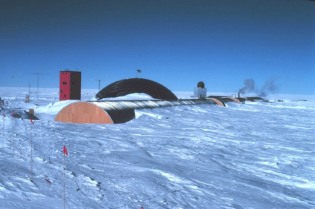Chapter 5
Air Temperature

(Credit NOAA)
South Pole Station,
Antarctica, one of the coldest places on Earth
The temperature of our atmosphere is
controlled by a complex set of interactions
between the biosphere, lithosphere, hydrosphere,
and atmosphere. Energy is constantly
exchanged between the surface and the air above,
as well as circulating around the globe. Here
we'll look at what controls the air temperature at
a particular place by examining radiation and
energy exchanges between the earth and air above.
Then we'll examine how the global circulation of
air and water affects air temperature.
Learning Outcomes
By the end of the chapter you should
be able to:
- Define temperature and describe how air
temperature is measured.
- Explain what controls daily and seasonal
temperature variations.
- Determine the temperature gradient using
isotherms.
- Calculate average daily and annual
temperature, daily and annual temperature range,
determine seasonal temperature lag.
- Explain the global pattern of air temperature.
- Summarize the effects of global warming on
temperature patterns.
See if you are ready for this chapter by Getting
Ready for Chapter 5: Air Temperature.
You may view a list of chapter
topics by clicking the "Topic Outline" link or go
directly to the first topic by clicking
"Continue".
Previous
| Topic Outline | Continue
|